You’re tired of constantly cleaning a 2,500-square-foot space, paying hefty home maintenance costs, and feeling distant from your loved ones in your own home. Your goal this year is to minimize your space and maximize your life.
Research shows that over 50% of people in the U.S. are open to living in tiny spaces, so you’re not alone. A major motivation to live in smaller spaces is to make life simpler.
Not all tiny spaces are the same, though. Should you transition to a tiny house or an RV? Let’s explore the ins and outs of tiny house vs. RV living.
Tiny House Living
Tiny homes are typically 500 square feet at a maximum. Customization is effortless with these small homes, so you can design one to suit your specific aesthetic preferences and your family’s needs. You can create a home that reflects your lifestyle and personality.
A significant benefit of a tiny house is that it may provide a feeling of permanence since it can feature a permanent address. It’s an ideal option for enjoying a community and a fixed location.
Another reason to choose a tiny house is that it’s generally larger than an RV. Some individuals also find tiny houses more attractive and charming than RVs since they can be designed beautifully.
RV Living
RVs are usually between 200 and 400 square feet. Recreational vehicles come in numerous price points, sizes, and shapes.
You can easily find the right RV fit for your travel goals, whether you want a luxurious motorhome or a basic trailer that folds out. Either way, an RV — like a Leisureland new RV — makes it easy to explore locations ranging from the Grand Canyon to the Great Smokies in North Carolina and Tennessee.
Individuals considering tiny house vs. RV maintenance costs will find that an RV is usually simpler and more affordable to maintain than a tiny house due to its smaller size. Another benefit of RVs is that many campgrounds provide RV amenities. Excellent amenities to look for include the following:
- Spacious and level campsites
- Hot tubs and pools
- Sewer, water, and electricity connections
- Card-operated washing machines and dryers
- Trash pick-up
- Campground activities (e.g., bingo nights)
- Clean bathrooms
People exploring tiny house vs. RV cost details will also discover that RVs usually cost less since they’re made with lightweight materials (e.g., aluminum or fiberglass), which are usually cheaper than traditional construction materials (e.g., wood or brick). Simpler RV models are especially more wallet-friendly for those interested in living in an RV full-time.
Tiny houses typically cost between $10,000 and $150,000 based on factors like design, size, and materials. An RV may cost between $20,000 and $50,000, although larger models may cost $100,000.
Embrace Tiny House vs. RV Living
Several factors should be considered when exploring tiny house vs. RV living. Tiny houses offer numerous benefits, including being larger than RVs and offering a feeling of permanence. RVs’ benefits include being easy to travel with and less expensive to buy and maintain.
Consider the many above-listed differences between tiny homes and RVs as you seek the right fit for your lifestyle. Also, if you enjoyed reading this article, check out our other “Lifestyle” section articles for more great content.


















Comments